Here is a detailed guide on how to use the laughing Buddha, which is considered a lucky décor item, in your household
The laughing Buddha is considered a symbol of happiness, abundance, contentment, and wellbeing. Laughing Buddha statues are considered auspicious and are often kept in homes, offices, hotels, and restaurants, for positive energy and good luck.
Significance of laughing Buddha statue at home
The laughing Buddha is believed to be a 10th-century Chinese monk, named Budai. The statue of the laughing Buddha reminds us to be grateful, overcome obstacles, and most importantly, be happy in life. In the Feng Shui tradition, the reason for buying and placing statues in the home is to correct a certain imbalance in one’s life. Although it is a symbol from Feng Shui, Vastu Shastra practitioners also encouraged the placement of laughing Buddhas at home. The laughing Buddha bears a similarity to Kubera, (the god of wealth). So, Indians associate it with prosperity.
Laughing Buddha statue material
Laughing Buddha statues are available in wood, metal, stone, porcelain, etc., and are usually painted in gold color. It is a belief that if one rubs the belly of the figurine every day with an affirmative mindset, their wishes will be granted.
Laughing Buddha statute colors
Though the most popular color of the laughing Buddha is golden yellow, which symbolizes prosperity and abundance.
Laughing Buddha in the black color is associated with the water element in Chinese culture. It helps to invite fluidity, good luck, and wisdom.
Laughing Buddha in green jade color stands for the wood element and is associated with growth, hope, and harmony.
A laughing Buddha statue in red is linked with fire that can help in passion, inspiration, and also good fortune. It is a color that denotes celebration and luck.
A white-colored or silver-ceramic laughing Buddha signifies wealth, peace, and happiness.
Different types of laughing Buddha
Laughing Buddha with a sack or bag

The sack signifies that the laughing Buddha gathers one’s suffering and misery and puts them in his sack and gives one abundance and positivity. The sack also represents wealth and good fortune.
Laughing Buddha holding beads
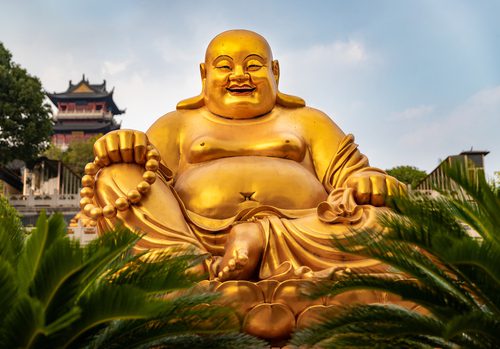
The beads symbolize meditation. The beads are believed to bring affluence and prosperity. Other interpretations are that it signifies pearls of wisdom or a fruit like a peach or apricot, representing health.
Laughing Buddha sitting on a gold nugget
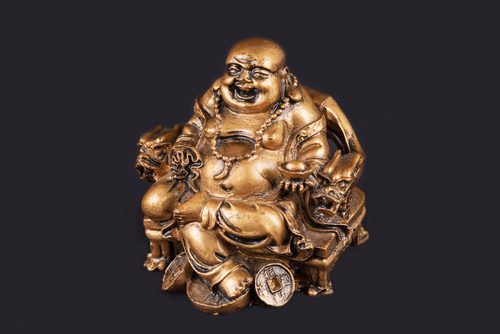
This statue of Buddha sitting on a large gold nugget and giving a smaller golden nugget, depicts him bestowing good luck. This statue will protect one from negativity and give good vibes.
Laughing Buddha with a fan and wu lou
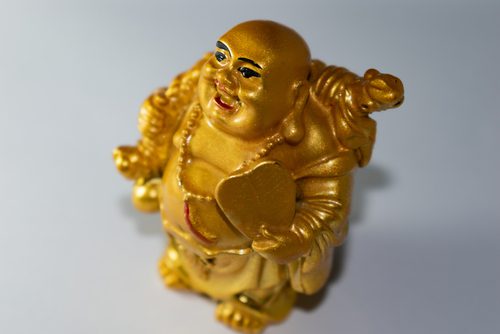
The figurine of a laughing Buddha with a fan in one hand and wu lou (bottle gourd) in the other hand bestows blessings and good health. The fan wards off misfortune while the bottle gourd protects from ill-health.
Laughing Buddha with a hat
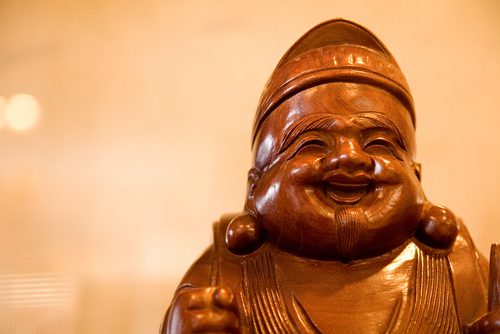
This statue symbolizes a long, happy, healthy, and relaxed life. Keep this figurine to remove troubles and be blessed with contentment, happiness, and stress-free life.
Laughing Buddha holding a gold ingot, with his hands upright
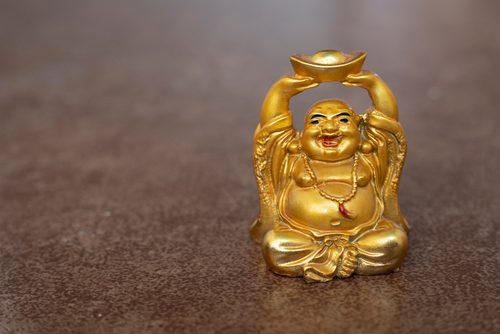
This pose symbolizes riches and good luck. It is believed that this pose attracts blessings from the heavens, prosperity, and ample luck for one’s endeavors.
Laughing Buddha with a bowl
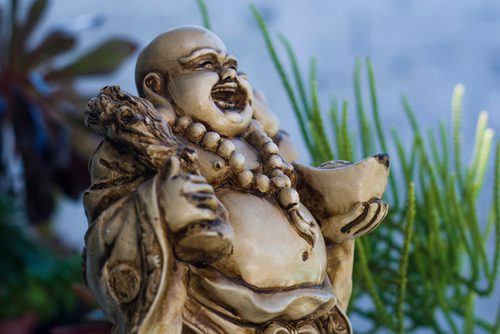
Laughing Buddha with a bowl represents a monk, who spends his life just for the happiness of people and in pursuit of enlightenment. The bowl symbolizes receiving good fortune and positive energy and higher wisdom.
Laughing Buddha surrounded by children
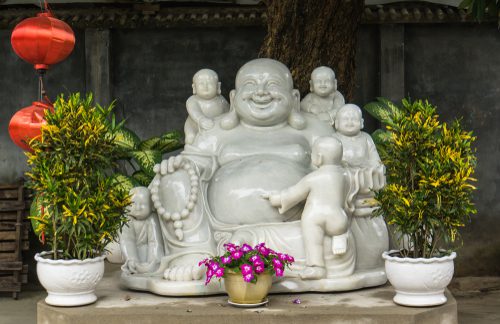
This laughing Buddha statue represents the well-being of the family. This figurine is also kept in the house to eliminate problems related to children. It improves fertility and overall health.
Laughing Buddha sitting on dragon tortoise

This statue is a symbol of a good career and success. It denotes that one will never face hurdles in education. The dragon represents strength and the turtle signifies stability.
Meditating laughing Buddha

For a calm and peaceful life, opt for a statue of a laughing Buddha in the state of meditation. Doing so will help you manage any stress in your life with ease and enjoy the serenity.
Laughing Buddha sitting on an elephant
This statue of a laughing Buddha on an elephant symbolizes good luck and fortune. An upward-pointed elephant trunk denotes happiness, prosperity, success, and wisdom. Place it in the living room, facing the main door, to attract positive energy.
Laughing Buddha with fish
This statue symbolizes the Buddha’s wealth and abundance. Keeping this statue at home brings prosperity, success, and financial gains, as fishes in Feng Shui represent abundance.
Laughing Buddha’s posture
- The sitting posture of Buddha is considered to be that of love and it symbolizes the stability of thoughts and tranquillity.
- The standing Buddha symbolizes treasure and happiness.
Placement and direction of laughing Buddha at home
According to Feng Shui, placing statues in the home helps to overcome the imbalance in one’s life, bring harmony and have a peaceful and prosperous life. Here, we look at the correct placement of the laughing Buddha at home.
- The east, the direction of the rising sun, is where the laughing Buddha should be placed. It is said to be the spot for good fortune for the family. To bring harmony and happiness to the family, place the idol in this direction.
- If the statue is placed in the southeast direction, it will lead to an increase in the wealth of the family.
- Laughing Buddha represents balance and inner peace. By placing the statue of a Buddha in the northeast direction, one can promote the energy of this corner and focus to gain wisdom.
- The energy that enters the house from the main door is welcomed by the laughing Buddha and it is activated and unwanted energy is cleansed. So, place the laughing Buddha on a corner table, diagonally opposite or facing the main door. Ensure that the statue faces the inside of the room and not outside.
- In the Feng Shui belief, each individual has a specific direction as his ‘Sheng Chi’, direction. Placing a laughing Buddha in this direction at home will enhance wealth and overall well-being.
- The Chinese consider it to be an auspicious symbol as its smiling face and a bag of wealth that it always carries is considered to bring happiness and prosperity. For this reason, it is advisable to place it in such a way that the laughing Buddha faces the inflowing chi from the entrance and not with its back to it.
Laughing Buddha on the work and study desk
Placing a laughing Buddha on the desk in the office helps in career prospects and to avoid clashes, disagreements, and spats with co-workers. For students, it will help to keep the laughing Buddha on their study table for better concentration and excellence in their academics.
Places to avoid keeping the laughing Buddha
- One should never place the statue in the kitchen, bathroom, or toilet.
- Never keep the statue on the floor directly. The statue should be placed at least at eye level.
- Always keep the area around the statue clean and clutter-free.
- Avoid placing the statue near electrical outlets, motors, or above any electronic appliance as it can disturb or block the aura of good energy.
- Never keep the laughing Buddha above a shoe rack.

Leave A Reply